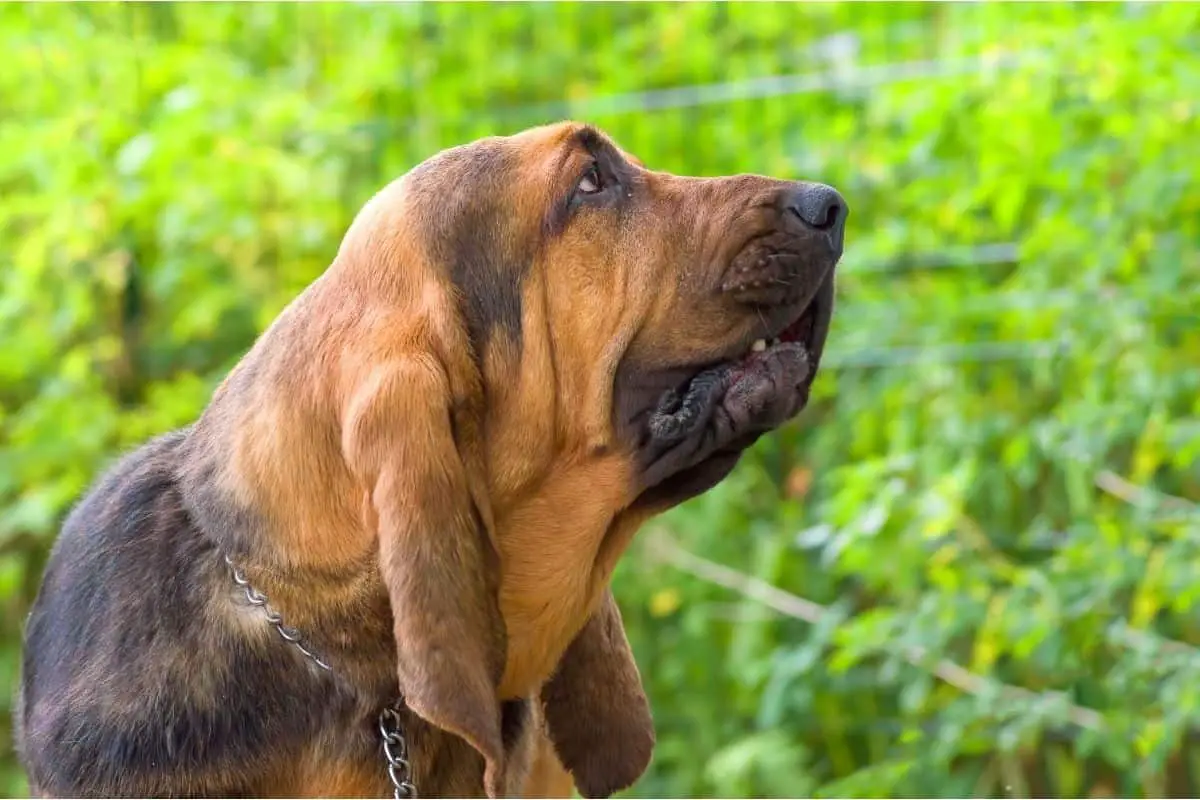Many people say that a dog’s behavior is based on how it was trained rather than it’s own nature. But let’s face it, not all dogs are wired to have the same temperament and personality when it comes to how receptive they are to training. This may lead you to think that Bloodhounds can be difficult to train due to their nature.
Bloodhounds are not easy to train. Even experienced trainers have a tough time training Bloodhounds because they are naturally wired to be independent, stubborn, and a bit lazy. That said, most Bloodhounds are generally well-behaved but may not be very receptive when it comes to obedience training.
Yes, the sad truth is that Bloodhounds can be quite difficult to train for any person out there. Still, that doesn’t mean that it is impossible to train one. If you decide to tackle the difficult task of training a Bloodhound here are some things to keep in mind.
Training Bloodhounds
It is important to note, for any dog owner out there, that dogs need to be trained as early as possible if you want them to grow up obedient and well-mannered enough. This is usually the case for most dog breeds as they might end up misbehaving or developing undesirable characteristics and habits when they grow old if they weren’t subject to obedience training at an early age.

Most dog owners and trainers would say that the way a dog behaves is a reflection of how its owner trained it at an early age. So, if the dog isn’t well-behaved or is quite disobedient later on in its life, it could be that you never trained your dog properly when it was a puppy.
Nevertheless, while it might be true that it is on the owner to make sure that the dog is trained well enough at an early age, there is also a chance that the dog is just simply difficult to train. It really depends on the breed of the dog because there are some breeds that are much more difficult to train in comparison to other breeds.
In that sense, one dog that tends to be more difficult than other breeds to train is the Bloodhound. This big, noble, and drooling dog can be an incredible household pet. However, if you are looking to make an obedient dog out of a Bloodhound, you will find that this will be a very difficult endeavor on your part.
The reason why Bloodhounds are generally difficult to train is that, like most hounds, they are naturally stubborn and independent. Bloodhounds were never historically bred to be obedient dogs even though they were bred to be hunting companions for humans. The reason why they are not as obedient as other hunting dogs or even other hounds is that they were most likely given a lot of independence by their hunting companions to try to sniff out prey and run after it themselves with or without the orders of their owners.
That said, the very fact that the Bloodhound was historically given plenty of freedom is one of the reasons why this dog is quite independent and stubborn when it comes to taking orders from its owner. Bloodhounds generally like being left alone to do what they want to do and are going to be quite difficult to train, especially when they weren’t trained well enough when they were still young.
However, what you need to know about Bloodhounds is that these dogs, while stubborn and difficult to train, are not prone to misbehaving. Bloodhounds are generally well-behaved and are quite gentle giants that won’t try to run around the house to chase after people or other animals. Instead, they are quite peaceful and behaved to the point that they would rather just sit around the house doing nothing at all. As such, they are not known to be the most energetic and pet to have in your family.
The fact that the Bloodhound is content with doing nothing all day long has made it earn a reputation for being a bit lazy. This lazy demeanor also makes it quite stubborn to train as the Bloodhound would rather ignore your orders to do what it wants to do, which is usually just nothing. So, if ever you do end up with a Bloodhound that is nearly impossible to train, at least know that the chances are slim that your dog will end up misbehaving or doing things that may cause problems.
Still, as stubborn and as independent as Bloodhounds may be, that doesn’t mean that it is impossible to train them. As long as you do your part and you make an early effort into training your Bloodhound, you will be surprised to know that it actually is possible for you to train your dog enough to overcome its natural temperament and to be more obedient and receptive to you.
Start them young
When it comes to training dogs regardless of whether or not they’re a Bloodhound, it is essential that you always start training them as young as possible. That’s because dogs understand what’s normal and not normal during their first three months. Of course, you also have to consider the fact that puppies are much more receptive to learning new things as compared to older dogs.
Another reason why you need to start training your Bloodhound early is that its natural personality and temperament haven’t taken over yet. That simply means that it still is learning the ropes of what it is to be a dog and it hasn’t developed the usual traits and qualities that Bloodhounds naturally end up developing as they get older.

Moreover, Bloodhounds are actually quite intelligent regardless of how stubborn they may be. That means that, if you start them young and begin training them at an early age, they will quickly understand the importance of what it means to be obedient.
So, as early as possible, you should try to teach your Bloodhound some basic commands such as “sit” or “stay”. As intelligent as Bloodhounds may be, try not to complicate things by teaching your dog plenty of different commands that it might be too stubborn to try to learn or remember. You should remember that a Bloodhound is not very receptive to training, which means that it won’t end up becoming as obedient as competition dogs are in terms of how many commands they are willing to learn and understand.
Of course, Bloodhound puppies are quite playful by nature even though as adults they are much more laid back. Because of how they are more likely to move and play while they are still young, Bloodhound pups can be easier to train considering that they haven’t developed that somewhat lazy personality yet.
Positive reinforcement is important
Another thing that you should remember when training a Bloodhound is that positive reinforcement will always play an important role in training your dog regardless of how old or young it may be. After all, dogs are more likely to remember certain commands and orders as long as they believe that there is something waiting for them at the end of obedient action. That’s why you need to use positive reinforcement as much as possible.
During the earlier stages of training your Bloodhound, use treats as your way of positively reinforcing your dog’s behavior. Any dog, regardless of how naturally stubborn and independent it might be, is a sucker for treats and rewards. So, as long as you know how to time your treats and how to reward your dog the right way, you can end up having a pretty obedient Bloodhound by making use of positive reinforcement.
When using positive reinforcement, it is essential that you gradually take away the reward at the end or perhaps replace it with a simple show of appreciation by telling your Bloodhound “good boy/girl” or some other form of positive affirmation. Of course, you should always start with the treats, but once you realize that your dog has mastered the art of following orders when it is expecting treats at the end, you can gradually remove the treats from the equation until your Bloodhound will begin to associate your commands with certain actions they need to do regardless of whether or not there are treats.
Tips for training your Bloodhound
Here are some additional tips that would make training your Bloodhound easier:
- Bloodhounds are large dogs that can be energetic from time to time even though they are widely portrayed to be lazy dogs. That means that they need to be given frequent exercise, and not giving your Bloodhound regular exercise can lead to it developing destructive habits.
- You need to give plenty of room and space for your Bloodhound to move around, especially when you are training it as this dog breed is large.
- If your Bloodhound is stubborn, be patient because this dog is just naturally disobedient. Don’t try to show frustration because that will just make things worse on the part of this wonderfully independent breed.
- You need to be able to show who is in charge. Bloodhounds are better left for owners who know how to take charge and can assert command without being harsh or physical. If your Bloodhound realizes that you are too weak or passive to take control, it won’t be receptive to any of your commands.
- Keep your Bloodhound away from small things because it can be frustrating whenever it chews or swallows something that is small enough to fit its mouth. In that regard, using small balls or toys when training your Bloodhound should be a definite no because of how this dog tends to swallow almost everything so long as the object is small enough for its mouth.
- Socialize your Bloodhound as early as possible. This will make it easier for you to train it because of how it has gotten used to being around other people.
- Keep a cloth or some paper towels close by when training your Bloodhound because this dog can be quite messy when drooling. Its flappy mouth doesn’t hold saliva well enough and will cause drool to easily escape from its mouth.
People Also Ask:
Do Bloodhounds make good pets?
Bloodhounds make excellent family pets. They are large, gentle and friendly dogs who do well with children and make loyal companions. While Bloodhounds can be stubborn, if they are trained properly at an early age they can learn to be obedient.
How long does it take to train a bloodhound?
Training a Bloodhound will take several months of consistent action. It is important to remember that every dog is different and some will learn faster than others. However, no matter how intelligent your Bloodhound is it will take several months for them to be properly trained.

